Off the table boy!
How do we get our dog to stay off the table? The natural instinct would be to:
- Punish it for trying to get onto the table
- Reward it if it does not try to get onto the table
Simple right? Unfortunately – there are nuances to it, and this is a mistake that I myself made.
Issue
What is the issue with the above proposal:
- Punish it for trying to get onto the table
- Reward it if it does not try to get onto the table
Let’s start with the first plan, Punish it for trying to get onto the table. To punish the dog when it’s trying to get onto the table, leaves the following questions unanswered:
- What is the punishment that should be applied?
- What is desired behaviour that the dog should exhibit, to remove the punishment?
- What behaviour are we punishing?
- How do we ensure that the dog is clear about the desired behaviour to exhibit?
What punishment to use?
Punishment refers to any action that is averse to the dog. This is a spectrum of actions ranging from simply ignoring the dog (not giving it your attention), to causing physical hurt to discourage the dog from exhibiting an undesired behaviour.

To know what type of punishment to use, we must have context of the scenario. In my case, the dog was trying to grab a steak from the table. The punishment selected was:
- Gentle restraining dog by blocking his chest with my arms when he is trying to access the table
- Do not give him any attention for 5 minutes whenever he tries to access the table
Application of both of the above techniques are inaccurate, and causes confusion for the dog – because the dog is unclear of the desired behaviour it needs to exhibit to remove the punishment.
We will circle back to this, when we put everything together, and rectify the inaccuracy of the methods applied.
What is the desired behaviour?
A punishment first approach normally thinks of how to stop the undesired behaviour. In our case, the dog trying to get onto the table.
However, it is unclear to the dog what is the desired behaviour – there is no magic, to communicating the desired behaviour to the dog. If something is not communicated, the dog will not know – same as humans.
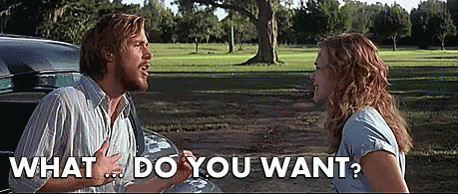
For our scenario, we punished it by:
- Gently resratining and pushing him off the table
- Ignoring him for 5 minutes
Without being clear of the desired behaviour to exhibit, chances are the dog would get
- Frustrated, and exhibit other undesirable behaviours. Note: This can lead to subsequent behavioural problems
- The dog may simply be confused, and try to get onto the table again
What behaviour are we punishing?
To make it even worst, we’ll bring your attention to the 5 minute timout punishment approach. Our objective was as follows:
- Punish it for trying to get onto the table
- Reward it if it does not try to get onto the table
But the actual execution of the technique was as follows:
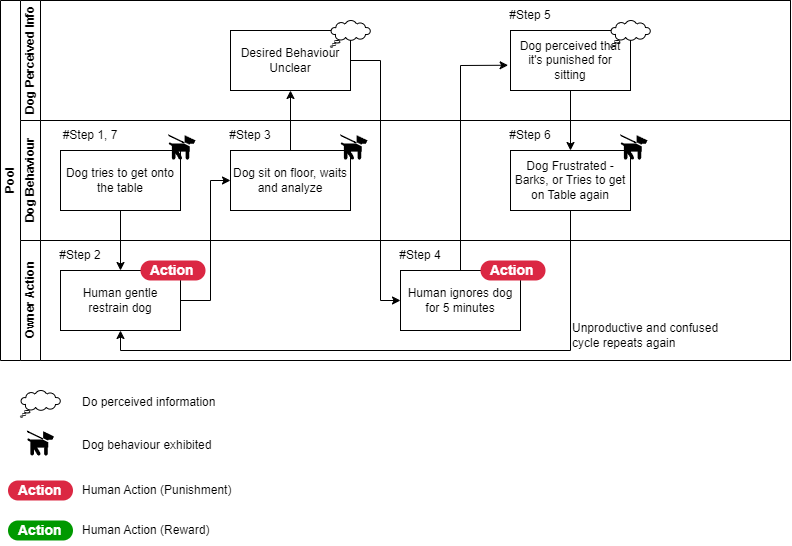
- Dog tries to get onto the table
- Human gently restraint the dog and push the dog off the table
- Dog sits on the floor, waits and analyzes the next step
- Human ignores dog for 5 minutes – to punish the dog for getting onto the table
- Dog completes analysis and assessed that he is getting punished for sitting and waiting on the floor
- Dog is unclear of the next step
- Exhibits frustration and displays other undesirable behaviours such as barking or
- Gets confused that sitting and waiting is bad, and tries to jump onto the table for attention
- When the dog jumps onto the table, we repeat step #2
- gently restraint the dog and push him off the table
- ignore the dog for 5 minutes because he tries to jump onto the table
- Dog perceives that jumping onto the table gets at least some attention
- Dog gets confused and repeats the behaviour that gets attention (tries to jump onto the table)
Once it’s spelt out like that – it is super obvious that I was actually confusing the dog regarding the expected desired behaviour. The application of the technique is completely inaccurate (some would go as far to say wrong – okay fine it’s wrong lol).
Furthermore, we were supposed to reward the dog if he does not try to get on the table (a.k.a., waits patiently on the ground). But the application of the technique actually punishes this behaviour, which further confuses the dog.
How to ensure the dog understand the expected desired behaviour
To solve for the confusion that I have caused, a different approach is required. The approach would need to:
- Ensure clarity of the desired behaviour
- Ensure reward of the desired behaviour
- Punishment can be used as a supporting tool – but sparingly, as it’s difficult to be precise with punishment (as explained above)
This is where the hype R+ etc. comes from – but bare with me, there are some merits to it besides simply technical jargon. We’ll take this through in the next section – the resolution.
Corrected Implementation
We resolve the issue by ensuring a desired behaviour first approach. So, the plan is as follows: 
- What is the desired behaviour:
- Sitting and waiting patiently on the floor
- Lying down and patiently waiting on the floor
- Going to his toys and playing with his other toys (not my steak)
- Watching the table intently but NOT jumping onto the table
- That’s right, he can sit and wait. We will give him the food, but he should not help himself
- Monitor for the desired behaviour and reward
- Monitor for pre-cursors of undesired behaviour, and redirect to any of the abovementioned desired behaviour
- Ensure that the undesired behaviour does not lead to any success (for my example, he should not get any steak)
Note: I leave out punishment, simply because it’s too difficulty to apply effectively. If you are an experienced professional, that can be 99.9% sure that your dog would know the expected desired behaviour to remove the punishment – please proceed. But, for me personally – punishment is not required, difficult to implement and simply ineffective for the general dog owner population.
Desired Behaviour: List, Monitor and Rewards
Using the desired behaviour first approach, it forces you to think through for the dog, the expected behaviour. The dog does not have to second guess what you want – we are afterall, smarter than the dog right lol.
It does take a little more processing power from our end, to think through – but once you have listed out all the desired behaviour, the surface area where you can actually apply the technique (reward the desired behaviour) increases tremendously!
There are many different behaviours that you can re-inforce, that would keep the bugger away from the top of your table.
As for the reward, this can range from just saying Good Boy! to giving a high-value treat. Depending on how much you would like to reinforce the desired behaviour, you may select the technique to be applied accordingly and test it out.
Also – rewards based reinforcements are more forgiving. Suppose your timing is off, or incorrect – the next step is to try again. The risk of the dog getting frustrated or exhibiting undesired behaviours as a direct outcome of this engagement is minimal (because there is nothing aversive being applied to the dog). Fascinating right?
Monitor Pre-cursors of Undesired Behaviour, Redirect!
Alas, the truth is out – positive reinforcement is no silver bullet. You still need to continue monitoring for pre-cursors of undesired behaviours.
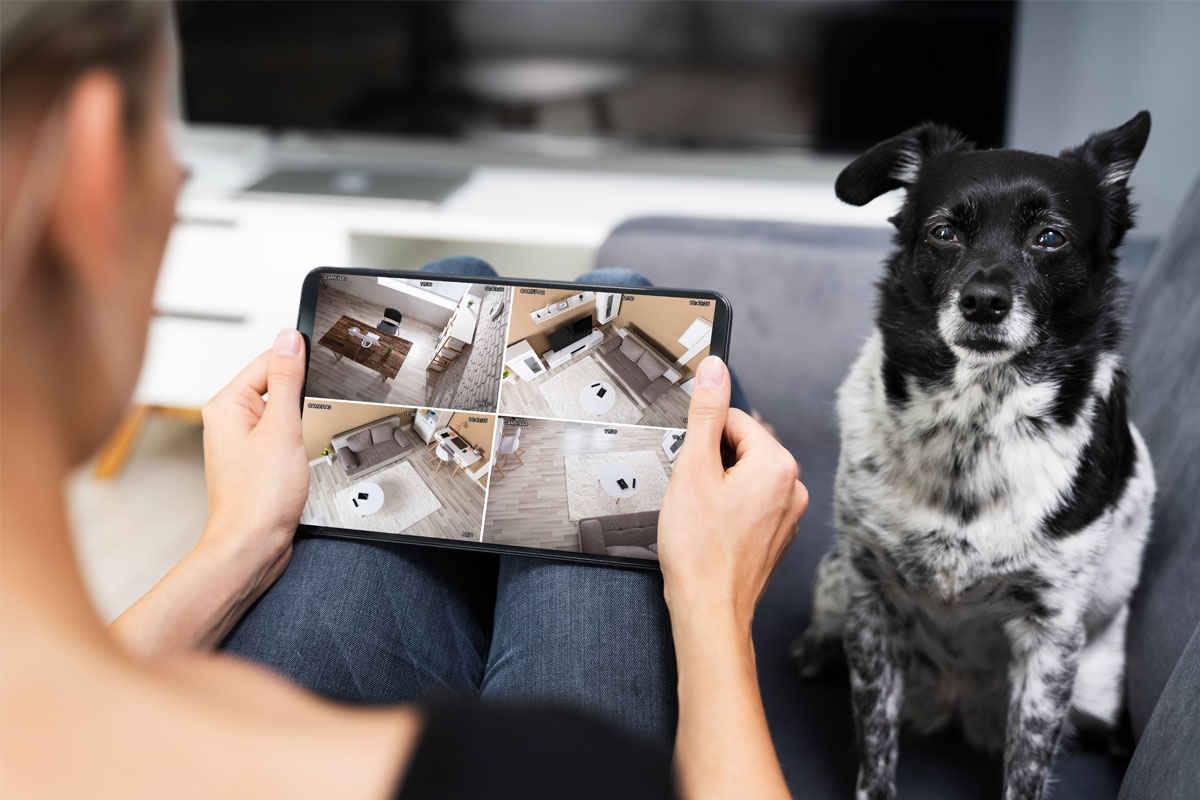
For me, Storm tends to have an eager posture and crazy eyes right before he tries to get onto the table. When this behaviour is exhibited, it’s my responsibility, to catch it in time, and redirect. An example flow is as follows:
- Shafik walakaka friends and colleagues eating happily on dinner table
- Actively monitor the dog for pre-cursors of undesired behaviour
- Have a bunch of treats standby, to reinforce a desired behaviour (so that the undesired behaviour does not manifest)
- Stormy gets into an eager posture and crazy eyes shows
- I will first distract him by simultanesouly
- Standing up
- Saying “No Stomry”
- Next I would walk around with a treat to lure him away from the table:
- To a sitting posture
- To a down posture
- And also optionally give him his own toys to chew on
- On sitting down, or lying down, I will give him the treat as a reward
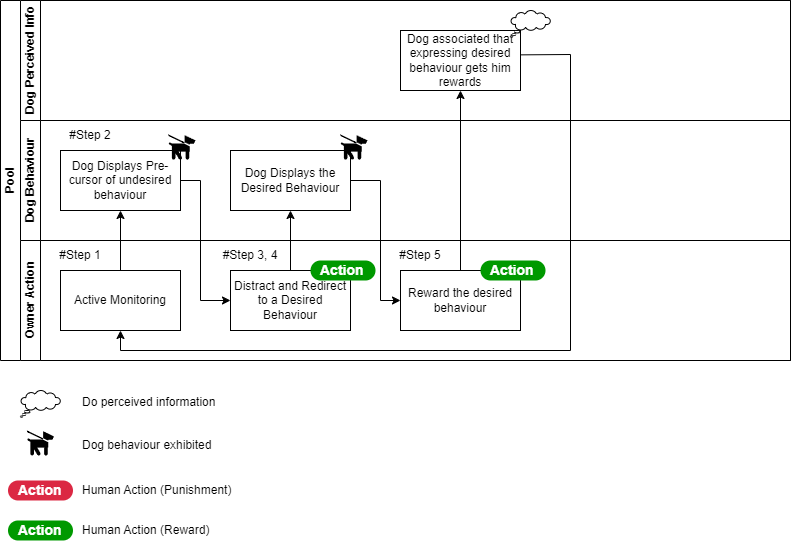
Steps #1 - #5 is a repetitive process, repeated until Stormy settles or learns some table manners. Might think this is alot of hardwork, and almost unfeasible – I think so too lol. But, this is the basal level of effort that we’d need to put it, to ensure he dog is brought up well. Hence, bo pian.
Ensure not to reinforce the undesired behaviour
Last but definitely not least, we need to be careful to ensure that the undesired behaviour is never reinforced.
We all agreed that the process of modifying the dogs behaviour is hardwork in the previous sections – this work can be undone, if mixed signals are given to the dog (a.k.a., reinforcing an undesired behaviour)
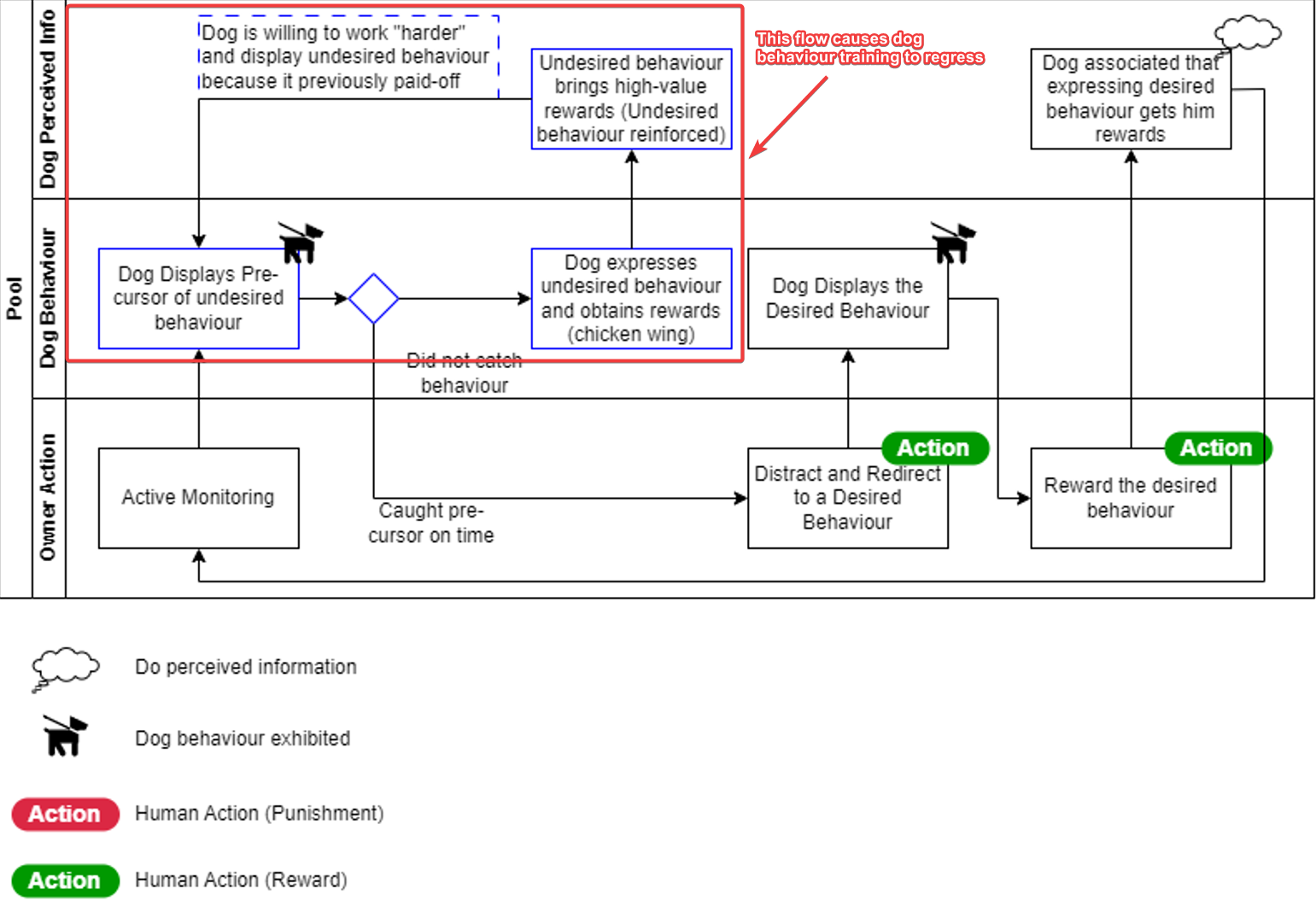
One example that occurred to me was a chicken wing left on the table. As we were clearing out the plates, our furry pal storm snuck onto the table and managed to grab a chicken wing. We tried to stop him, but he was too quick.
Why is this bad? Because now he learns, that if he puts enough effort to get onto the table, it is possible to receive a chicken wing (an extremely high-value treat for Stormy). Due to this regression, it set us back several days of carefully managing and teaching him that he should not climb onto the table.
Although no lives were lost, it does get tiring when already completed work is undone – definitely a tip that I wish I knew before carelessly leaving the chicken wing on the table
Thank You!
That’s all folks for this piece. Thanks if you made it this far – I definitely learnt alot, and firmed up my fundamentals on being a better dog handled when writing this piece.
Enjoyed it too ^^ and this would not have been possible without the expertise of my beloved wife.
For dog owners out there, feel free to holla on your experience, and also how you think we can improve the communication with our dogs to ensure a harmonious environment/household.
Otherwise, until next time then!
Peace and Love
Shafik Walakaka